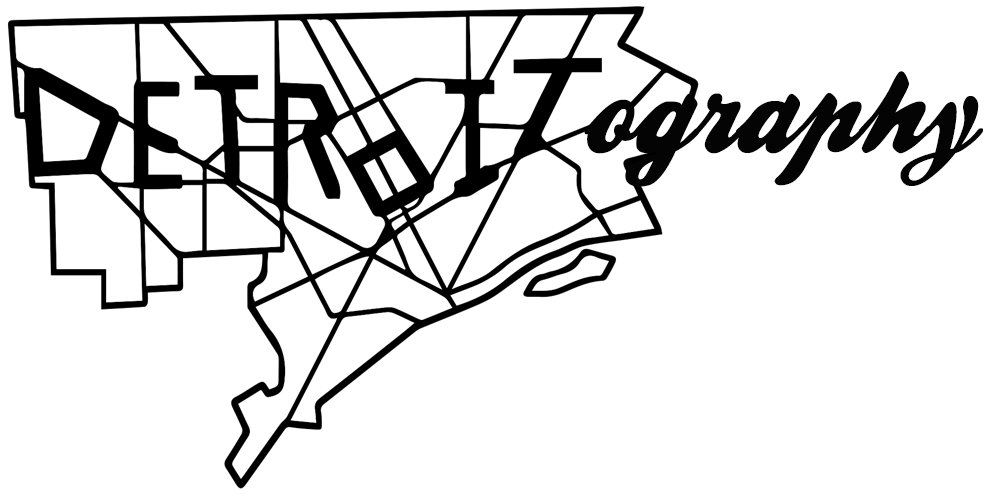Can Detroit really be compared to any other city? No doubt everyone has tried comparing crime rates, economy, and poverty levels in Detroit with other troubled cities. A few groups have even tried fitting different city land areas into Detroit’s 139 square (land) miles. It always seems that Detroit has too much or too little of something for a city to city comparison to make much sense. Rob Linn had similar thoughts and instead of comparing land area or other commonly compared attributes he analyzed infrastructure density (feet of street per resident) as a method to debate the misguided “rightsizing” push. Rob found that Detroit had a high rate of “feet of street per resident” which caused some areas of the city to appear more vacant when in reality they had healthier infrastructure density.
The 2010 Census population for Detroit was 713,777, closer to San Francisco’s. Imagine San Francisco’s southern edge lined up with the river front and perhaps we would see what proponents of a “condensed” city envision. Should the city condense to its former 1913 borders and focus on making services work within that area before moving outwards or would that just be an exercise in discrimination and inequality? Still others have suggested part of Detroit’s downfall was that it stopped expanding its borders. Check out the “map of Detroit” as an amalgamated region.
 I wondered what other cities would actually make sense to compare Detroit to as far as land area, population, and density. Manhattan, New York City is a wild comparison just because the land mass and density of people is so different from Detroit. Boston is interesting because of its area and population size, but San Francisco is more comparable because of its similar population size to Detroit and its smaller corresponding square-mile area.
I wondered what other cities would actually make sense to compare Detroit to as far as land area, population, and density. Manhattan, New York City is a wild comparison just because the land mass and density of people is so different from Detroit. Boston is interesting because of its area and population size, but San Francisco is more comparable because of its similar population size to Detroit and its smaller corresponding square-mile area.
| State | City | Population | Land (sq mi) | Density (/sq mi) |
| NY | New York | 8,175,133 | 302.64 | 27,012.50 |
| CA | San Francisco | 805,235 | 46.87 | 17,179.22 |
| MA | Boston | 617,594 | 48.28 | 12,792.70 |
| PA | Philadelphia | 1,526,006 | 134.1 | 11,379.50 |
| DC | Washington | 601,723 | 61.05 | 9,856.50 |
| MD | Baltimore | 620,961 | 80.94 | 7,671.50 |
| MI | Detroit | 713,777 | 138.75 | 5,144.30 |
| NV | Las Vegas | 583756 | 135.82 | 4,298.20 |
| CO | Denver | 600,158 | 153 | 3,922.60 |
| AZ | Mesa | 439,041 | 136.45 | 3,217.50 |
| GA | Atlanta | 420,003 | 133.15 | 3,154.30 |
| NC | Charlotte | 731424 | 297.68 | 2,457.10 |
| TN | Memphis | 646,889 | 315.06 | 2,053.30 |
| TX | El Paso | 649,121 | 255.24 | 2,543.20 |
| OR | Portland | 583,776 | 133.43 | 4,375.20 |
| WA | Seattle | 608,660 | 83.94 | 7,250.90 |
| WI | Milwaukee | 594,833 | 96.12 | 6,188.30 |
I choose to compare Detroit in land mass, population density, and population size with 16 other cities. I first chose the common comparisons from the popular comparison map (Boston, New York City, Washington D.C., San Francisco), then chose similar population sizes (Charlotte, El Paso, Baltimore, Memphis), followed by similar population density (Seattle, Denver, Milwaukee, Las Vegas) and finally looked at similar land sizes (Philadelphia, Atlanta, Mesa, and Portland).
While there is still no great comparison city for Detroit, looking at how the city matches up with many of its comparison cities is an important exercise. There may not be any direct comparisons, but there are definitely specific policies and strategies that Detroit can utilize from cities that it is often compared to and vice versa. The details are where better comparisons can be made rather than the surface level comparisons of land area, population, and density.


Reblogged this on Alex B. Hill.
Pingback: Map: Four Detroits, One Houston | DETROITography
Pingback: Life without money in Detroit's survival economy | fixnews.info
Pingback: Life Without Money in Detroit’s Survival Economy | US-China News
Pingback: Oh! Detroit! – Catherine Haustein
Pingback: Absolutely adore anything like this – Detroit Tigers Fans Homeplate